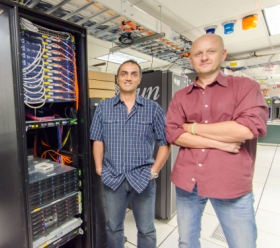Aug 16 2013
Two NJIT researchers have demonstrated that using a continuum-based approach, they can explain the dynamics of liquid metal particles on a substrate of a nanoscale. “Numerical simulation of ejected molten metal nanoparticles liquified by laser irradiation: Interplay of geometry and dewetting,” appeared in Physical Review Letters (July 16, 2013).

The evolution of fluid drops deposited on solid substrates has been a focus of large research effort for decades, said co-author Shahriar Afkhami, an assistant professor in the NJIT Department of Mathematical Sciences. This effort has become particularly extensive on the nanoscale, due to the relevance of nanostructures in a variety of fields, ranging from DNA sequencing to plasmonics and nanomagnetism. And the research also applies to liquid crystal displays and solar panel designs.”
In this work, Afkhami with NJIT Professor Lou Kondic, also in the Department of Mathematical Sciences, studied the liquid metal nanostructures placed on solid substrates. The study is of direct relevance to self- and directed-assembly of metal nanoparticles on surfaces. For example, the size and distribution of metallic particles strongly affects the yield of solar cell devices, Afkhami said.
In this work, however, the researchers demonstrate that using a continuum-based approach is appropriate on the nanoscale, where the basic assumptions of continuum fluid mechanics are pushed to the limits. The pair’s research is the first attempt to utilize state-of-the-art simulations based on continuum fluid mechanics to explain the dynamics of liquid metal particles on a substrate on the nanoscale.
“We demonstrated that continuum simulations provide a good qualitative agreement with atomistic simulations on the length scales in the range of 1-10 nm and with the physical experiments length scales measured in the range of 100 nanometers,” added Kondic.
Kondic is involved in the mathematical modeling and simulating of granular materials, as well as in development of numerical methods for highly nonlinear partial differential equations related to the flows of thin liquid films. In 2005, Kondic received a Fulbright Foundation grant and traveled to Argentina to study the dynamics of non-Newtonian liquid films involving contact lines. He currently leads four federally funded projects totaling more than $800,000.
Afkhami uses computational and mathematical modeling to help researchers better understand a range of real-life engineering phenomena. His work includes examining biomedical systems, polymers and plastics, microfluidics and nano-materials. His research looks for the existence of solutions and issues involving fluid flows from stability to asymptotic behavior.
Afkhami’s current research project is to numerically discover a better way to understand the dynamics of mixtures of fluids. The effort will tie into his new three-year NSF $252,000 grant (2013-16) to develop a state-of-the-art computational framework for polymeric liquids. The fruits of this labor will eventually have a broad effect in complex applications, such as how blood and other bodily fluids flow in microfluidic devices as well as finding better ways to improve the flow of emulsions when blending or processing polymers.